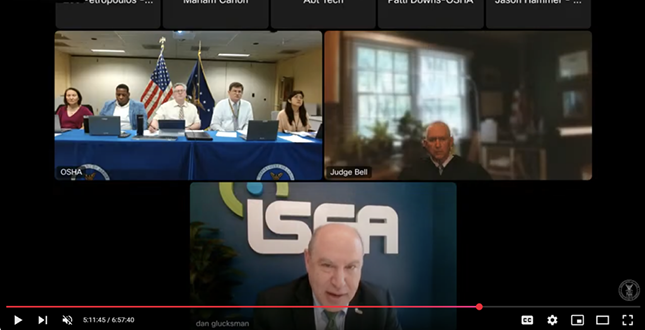ARLINGTON, VA -- As record-breaking heat waves sweep the country, the Occupational Safety and Health Administration (OSHA) is moving forward on its proposed Heat Injury & Illness Prevention Rule—a long-awaited federal standard aimed at protecting workers from the growing risks of occupational heat stress.

On June 25, ISEA Senior Director of Policy Dan Glucksman joined four members of International Safety Equipment Association’s (ISEA) Heat Stress Solutions Product Group to deliver public testimony at OSHA’s hearing on the proposed rule.
Their message to regulators was clear: Today’s cooling PPE and hydration technologies offer proven, effective protection that must be considered as part of the solution.
“Heat stress is preventable—and we have the tools,” Glucksman told OSHA officials. “An effective standard should allow employers to use the full range of controls, including engineering solutions, work practices, hydration, and advanced cooling PPE.”
Joining Glucksman were:
Kayla Stevens, Carhartt
Lexi Engelbart, Ergodyne
Saif Islam, Carhartt
Bubba Wolford, Sqwincher
ISEA’s Message: A Smarter, More Flexible Standard
Throughout the hearing, ISEA’s panel reinforced several core messages:
Cooling PPE works—and should be part of the heat safety toolbox.
“Employers should not be restricted from using heat PPE, such as garments, active and passive cooling products, or electrolyte beverages,” Glucksman emphasized.
Different worksites and regions need different solutions. What works in a hot, dry climate may not be ideal in humid environments. Employers must be able to choose appropriate tools.
Standards and testing for cooling PPE are advancing, giving employers more confidence in selecting effective products.
“A one-size-fits-all approach won’t work for the diverse conditions American workers face,” added Kayla Stevens of Carhartt. “That’s why flexibility and performance are key.”
Addressing Misconceptions
During OSHA’s heat stress hearing, some stakeholders raised concerns that “cooling PPE doesn’t work.”
ISEA members firmly countered this claim, citing field data, product performance, and positive end-user experiences across industries.
“Products exist today that are safe and effective—yet may be overlooked if not recognized in the final rule,” said Glucksman.
Next Steps for ISEA Members
Following the hearing, ISEA and its Heat Stress Solutions Product Group will:
Respond in writing to OSHA’s questions about product performance and integration.
Review the hearing transcript to identify additional comments that merit response, particularly any misconceptions about cooling PPE.
Continue positioning ISEA members as trusted experts on heat stress prevention and PPE innovation.
Why This Matters
As global temperatures rise, heat injury and illness are fast-growing risks—not just in traditional sectors like construction, but in warehouses, utilities, manufacturing, and logistics.
OSHA’s potentially forthcoming national standard could be a game-changer—but only if it recognizes the full range of proven tools available today. That’s why ISEA members are helping shape the rule—so that effective, flexible, and innovative solutions can reach more workers and prevent more injuries. |
